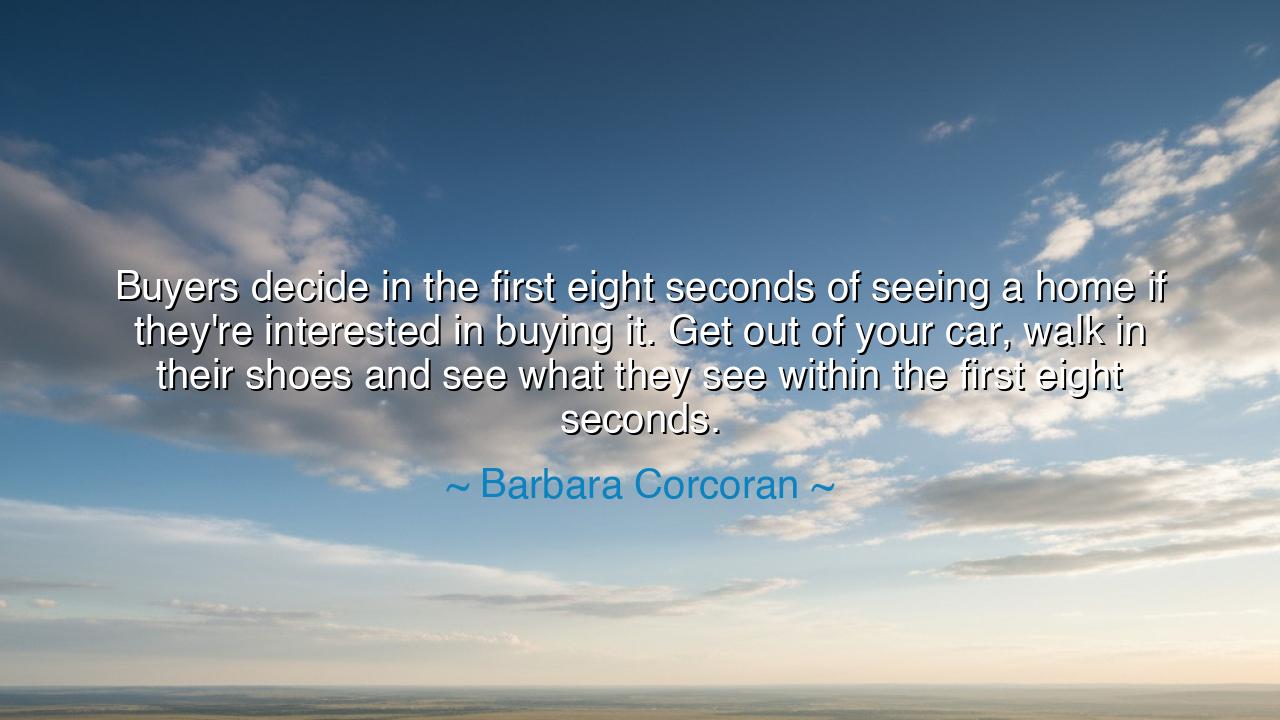
Buyers decide in the first eight seconds of seeing a home if
Buyers decide in the first eight seconds of seeing a home if they're interested in buying it. Get out of your car, walk in their shoes and see what they see within the first eight seconds.






In the words of Barbara Corcoran, “Buyers decide in the first eight seconds of seeing a home if they're interested in buying it. Get out of your car, walk in their shoes and see what they see within the first eight seconds.” — we hear not just advice for selling property, but a profound lesson on perception, empathy, and the power of first impressions. Beneath the language of real estate lies a truth that transcends business: that human beings make judgments swiftly, instinctively, and often irrevocably. Those eight seconds — brief as a breath — hold the weight of opportunity, for within them the heart speaks before reason has time to intervene.
The ancients would have understood this well. The philosopher Aristotle wrote that we do not simply perceive the world — we interpret it through emotion and experience. What Corcoran calls the “first eight seconds” is that sacred window where the senses, unfiltered by logic, decide whether to open the heart or close it. In the context of a home, it is the scent of fresh air or the warmth of sunlight through a window; in the broader context of life, it is the first impression one leaves upon another — the light in the eyes, the bearing of the body, the spirit that precedes words. Those who master this fleeting moment wield the quiet power to shape perception and destiny.
But Barbara’s wisdom goes further. When she says, “Get out of your car, walk in their shoes, and see what they see,” she is calling for empathy, the ancient art of seeing through another’s eyes. She does not speak of manipulating perception, but of understanding it — of aligning one’s perspective with that of another. The wise merchant, the just ruler, and the true friend all share this gift: they do not impose their own view upon the world, but learn to feel what others feel. In business and in life alike, it is only through empathy that one can create connection — and connection, more than persuasion, moves hearts to act.
Consider the story of Cyrus the Great, the Persian ruler who built one of the greatest empires of the ancient world. When he conquered a new land, he did not rule with iron alone; he walked among his subjects, listened to their tongues, and sought to understand their customs. In doing so, he won their loyalty not by force, but by insight — by stepping into their world as Barbara teaches us to do. His ability to see as others saw transformed conquests into communities and strangers into allies. So too, in the marketplace or the meeting room, those who learn to “walk in another’s shoes” find not opposition, but understanding — not walls, but bridges.
The eight seconds Corcoran speaks of are more than a marketing principle; they are a mirror held to the swiftness of human judgment. The first moment of encounter — whether with a home, a person, or an idea — carries immense power. It reminds us that life itself is made of beginnings: every friendship, every opportunity, every act of creation begins with a spark, a glance, an opening of the heart. The wise, therefore, learn to honor the art of beginnings, to prepare themselves and their surroundings so that the truth of their intention can be seen clearly and without confusion. For the moment one first meets another’s eyes, the silent decision begins to take shape.
Yet this wisdom carries a warning as well. Those eight seconds reveal how easily we are swayed by appearance, how swiftly we form opinions that may endure unjustly. The ancients cautioned against this — the Stoics, for instance, taught that we must learn to pause before judgment, to let reason follow where emotion rushes first. So even as Corcoran teaches us to harness this truth for good, she also invites us to be mindful of it in ourselves: to look twice, to think deeper, to allow the unseen qualities — integrity, kindness, substance — to emerge beyond the surface.
In this, Barbara’s words unite two worlds: the practical and the philosophical. On one hand, she teaches mastery of perception — the wisdom of preparation, presentation, and awareness. On the other, she reminds us that the power to connect, to sell, to inspire, all begins with the humility to understand another’s point of view. The one who succeeds is not the one who forces others to see his vision, but the one who first learns to see through their eyes.
So let this teaching be carried forward as both strategy and scripture: honor the first moments, for they hold the seed of every outcome. When you meet another, when you speak, when you create — imagine those first eight seconds as sacred. Step outside yourself, as Barbara Corcoran advises, and walk in another’s shoes. Ask not only, “What do I wish to show?” but also, “What do they see, feel, and hope for?” For in understanding their vision, you unlock your own success — not only in commerce, but in the greater marketplace of life.






AAdministratorAdministrator
Welcome, honored guests. Please leave a comment, we will respond soon